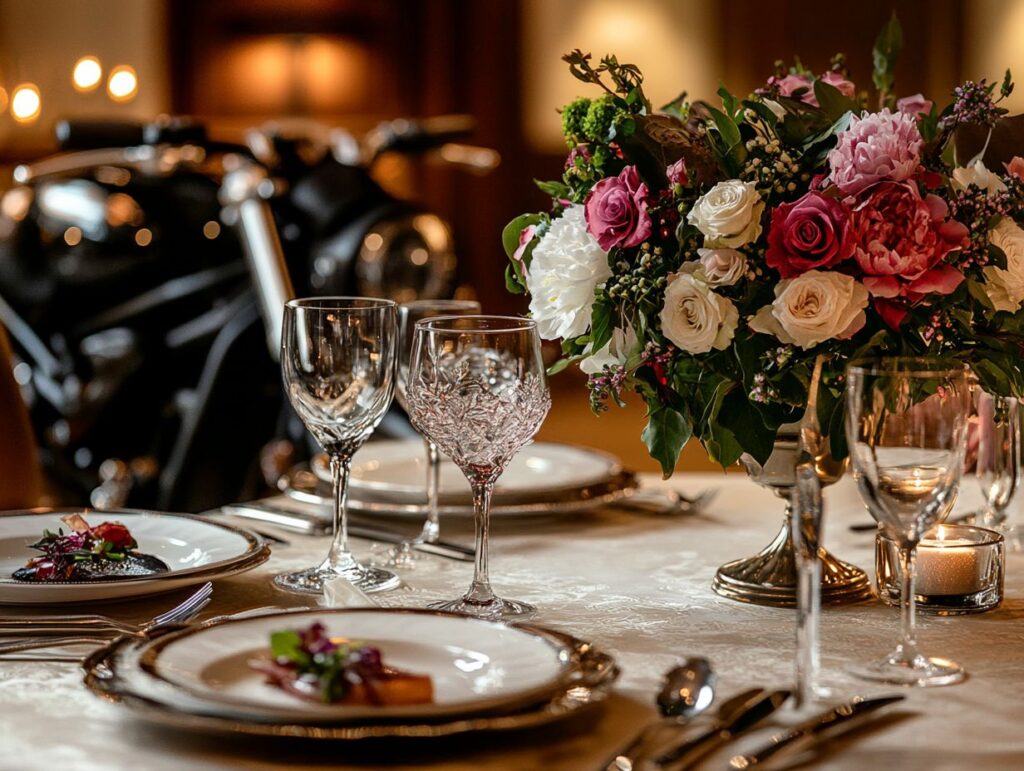Fine dining encompasses more than merely a meal; it represents an experience that engages all the senses.
This exploration aims to provide a comprehensive understanding of the intricate world of fine dining, examining its rich history, defining characteristics, and what patrons can anticipate during a visit to a fine dining establishment.
The discussion will also encompass essential etiquette, the significance of presentation, and innovative techniques that enhance the culinary experience. Additionally, factors influencing the pricing of this gastronomic adventure will be analyzed. This examination seeks to illuminate the essence of fine dining.
Table of Contents
The Definition of Fine Dining

Fine dining represents a sophisticated culinary experience distinguished by luxurious cuisine, artistic presentation, and a strong emphasis on exceptional service. This approach to dining fosters an interactive atmosphere that enhances the appreciation of culinary arts.
Typically, fine dining establishments prioritize seasonal ingredients and employ innovative techniques to create exquisite dishes that transcend the notion of a simple meal, transforming dining into a culinary journey.
Historically, fine dining has developed to embody an exclusive allure, mirroring the cultural and gastronomic trends of its era, thereby establishing itself as a hallmark of refinement and elegance within the culinary landscape.
Understanding the Concept and History
The concept of fine dining has its origins in the culinary arts that emerged during the French Revolution, significantly shaped by influential chefs such as Auguste Escoffier, who established the foundations for modern gastronomy and Michelin-starred establishments.
In the aftermath of societal upheaval, culinary practices underwent a transformation, as traditional aristocratic dining gave way to a more refined and accessible approach to gastronomy. This shift signified the emergence of restaurants as contemporary entities, moving beyond simple taverns to establishments that emphasized quality and presentation.
Prominent figures, including Marie-Antoine Carême, advanced techniques that prioritized artistic plating and sophisticated flavor combinations. By the late 19th century, the Michelin Guide began evaluating restaurants, thereby reinforcing the significance of excellence in dining experiences.
The pursuit of culinary prestige has continued to evolve, influencing numerous chefs and inspiring unforgettable gastronomic journeys.
Characteristics of Fine Dining
Fine dining is characterized by several key elements that set it apart from casual dining.
These include a sophisticated atmosphere, customized menus, and the utilization of seasonal ingredients, which are frequently prepared using innovative techniques that elevate both flavor and presentation.
Key Elements that Set it Apart

Key elements that distinguish fine dining include exquisite cuisine, which caters not only to taste preferences but also to health-conscious diets, thereby creating an interactive experience that fosters connections among diners. This environment often enhances romantic evenings and special celebrations.
Fine dining establishments take pride in utilizing only the highest quality, seasonal ingredients sourced from local farms and purveyors. This commitment to freshness and flavor enables chefs to craft unique dishes that are as visually stunning as they are flavorful.
The level of service in these establishments is unparalleled, characterized by attentive staff trained to anticipate guests’ needs, cultivate a welcoming atmosphere, and provide personalized recommendations. This meticulous attention to detail not only elevates the dining experience but also ensures that each visit is memorable, whether guests are celebrating a significant milestone or simply enjoying a night out.
The Fine Dining Experience
The fine dining experience encompasses significantly more than a mere meal; it represents an experiential dining journey that provides exclusive moments, often curated by a private chef.
This experience showcases global flavors within a meticulously crafted, refined atmosphere designed to engage all the senses.
What to Expect at a Fine Dining Restaurant
At a fine dining restaurant, patrons can anticipate an exceptional standard of service, elegantly presented dishes crafted from seasonal ingredients, and a selection of health-conscious menus that cater to a variety of dietary preferences, often reflecting the high standards characteristic of Michelin-starred establishments.
This dining experience is further enhanced by an elegant atmosphere, where soft lighting and exquisite table settings create a sensory delight. Guests are typically greeted by knowledgeable staff who possess a comprehensive understanding of the menu and wine pairings, thereby enriching the overall culinary experience.
Each course is thoughtfully curated, allowing patrons to appreciate culinary artistry while often introducing them to unique flavor profiles. The meticulous attention to detail in both the cuisine and the ambiance elevates an ordinary meal into an unforgettable occasion, ensuring that every visit is a celebration of gastronomy.
Learn more, Fine Dining Etiquette: A Guide to Rules and Best Practices
Etiquette and Dress Code

Etiquette and dress code are essential components of the fine dining experience, as exclusive dining establishments typically necessitate that patrons comply with particular standards of behavior and attire.
This adherence reflects the refined atmosphere and sophistication of the venue.
Proper Behavior and Attire
Proper behavior and attire are fundamental aspects of fine dining etiquette. Diners are expected to dress suitably for the occasion and demonstrate respectful conduct, thereby enhancing the overall experience of luxury cuisine within an exclusive dining environment.
The dining experience is notably enhanced when patrons don elegant attire, typically favoring formal or semi-formal options such as tailored suits or sophisticated dresses. Gentlemen are encouraged to wear jackets and ties, while ladies may choose refined ensembles that align with the establishment’s ambiance.
Maintaining a composed demeanor, employing polite language, and adhering to the guidance of the waitstaff are essential behaviors that complement the refined atmosphere of these venues. Additionally, refraining from using cell phones at the table and avoiding loud conversations significantly contribute to preserving the focus on the culinary offerings, showcasing an appreciation for the carefully curated dining experience.
The Art of Elevated Cuisine
The practice of elevated cuisine in fine dining highlights the culinary arts by employing innovative techniques, including molecular gastronomy, artisanal methods, and sous vide cooking.
These approaches work together to create distinctive and memorable dining experiences.
Innovative Techniques and Ingredients

Innovative techniques and high-quality ingredients constitute the foundation of fine dining, where chefs utilize methods such as molecular gastronomy and artisanal practices to transform seasonal ingredients into exceptional culinary creations that both surprise and delight the palate.
This transformative process frequently incorporates unexpected elements, including edible flowers, gourmet salts, and infusions, which not only enhance the flavor profile of the dish but also elevate its visual presentation.
For instance, the meticulous application of sous-vide cooking allows for precise temperature control, resulting in tender proteins that retain their moisture while being infused with aromatic herbs.
Additionally, interactive elements such as tableside preparations foster an engaging dining experience, inviting patrons to actively participate in the unfolding culinary journey.
These creative approaches underscore the artistry inherent in fine dining, celebrating the harmonious relationship between technique and taste.
The Role of Presentation and Service
In fine dining, the significance of artistic presentation and exceptional service cannot be overstated, as these elements collaboratively create an engaging and interactive experience that highlights the culinary arts in the most appealing manner.
The integration of visual aesthetics and attentive hospitality not only enhances the meal but also elevates the overall ambiance of the dining establishment. When a dish is meticulously plated, it captivates the senses even before the first bite is taken, generating excitement and anticipation among guests.
Moreover, the role of the attentive service staff is critical; they provide valuable insights into the ingredients and preparation of each dish, thereby enriching the guests’ understanding and appreciation of the culinary offerings.
This synergy between presentation and service quality is vital, as it cultivates an immersive experience that transforms each meal into a memorable occasion, reflecting the highest standards of culinary excellence.
The Cost of Fine Dining
The cost of fine dining can vary considerably due to several factors, including the exclusivity of the dining experience, the quality of the luxury cuisine, and the complexity of the dishes crafted by esteemed chefs.
These elements frequently influence the overall price point associated with such dining experiences.
Factors that Affect Price
Several factors influence the pricing of fine dining establishments, including the use of premium seasonal ingredients, the reputation of the restaurant, and the level of service offered in exclusive dining environments, all of which can significantly enhance the overall dining experience.
The geographic location of the restaurant is also a critical consideration; establishments situated in high-demand urban areas typically command higher prices due to increased overhead costs and the competitive nature of the market.
The chef’s reputation, often established through prior accolades and culinary excellence, can further elevate prices, as patrons are drawn to unique and innovative dishes created by renowned culinary artists.
Additionally, the ambiance and decor of the restaurant contribute to the overall aesthetic enjoyment of the meal, as fine dining seeks to provide not only quality food but also a multi-sensory experience that embodies artistry and sophistication.









